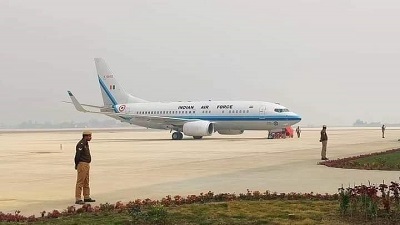Lucknow, (Asian independent) In view of the fact that the newly inaugurated Ayodhya airport will witness unprecedented rush on January 22 when the Pran Pratishtha ceremony takes place at the Ram temple, concerned officials have decided to adopt the ‘drop-and-move’ policy.
Airports Authority of India (AAI) engineering in-charge and project director Ayodhya Airport Rajeev Kulshreshta said, “We have completed all the civil and technical work inside the airport and only final touches are being given to the rest of work. However, on January 22 only about 100 flights (coming and going) would be accommodated. The airport is meticulously managing influx of these flights, mostly of VVIPs, by allocating tight time slots for both landing and take-off, necessitating efficient coordination to avoid congestion. It would be a drop and move affair for all the aircraft as we have limited parking facility in Ayodhya.”
The Ayodhya airport is preparing to handle the January 22 rush on a war footing. Requests for more than 200 flights (chartered and private) have been received by the airport authorities but only about 110 can be accommodated on that day.
A senior official of the Airports Authority of India (AAI) said, “Ayodhya airport is gearing up to handle more than 100 flights (coming and going included) on January 22, with over 200 flight requests pouring in, comprising both chartered and private flights.”
Director, Ayodhya airport Vinod Kumar said, “To handle the overflow, designated parking spaces in nearby airports such as Prayagraj, Kushinagar, Varanasi and Gorakhpur are being utilized. All these aircraft have been given parking slots at different nearby airports like Varanasi, Gorakhpur, Kushinagar and Prayagraj. This strategic approach aims to alleviate the pressure on Ayodhya airport, ensuring a smooth flow of air traffic.”
An official of Air Traffic Control said on condition of anonymity, “Strict adherence to allocated time slots is crucial, as any delay in reaching the airport on time may lead to the cancellation of landing permission or, at least result, in extended wait time in airspace.”
This comprehensive preparation reflects the airport’s ability to manage the flight operations effectively, at the same time safeguarding operational efficiency and minimizing disruptions during this anticipated rush on January 22.
He said, “The airport has a 2,200 metres long and 45 metres wide runway which can handle landing and take-off of Airbus A320, ATR-72 and Bombardier private jets. In the second phase the airport would be opened for international flights with the expansion of the runway to 3,200 metres. For night landing, we have IFR (Instrument Flight Rules) and CAT-1 landing facility for landing during fog. Under CAT I facility, the aircraft can land even when the visibility is as low as 60 metres.”
The 848-metre-long threshold has also been created which is in addition to the 2,200-metre-long runway. For commercial aircraft operations from Ayodhya airport, the runway has Doppler Very High Frequency Omni Range (DVOR), a homing gate system which is a standard International Civil Aviation Organisation (ICAO) ground-based radio navigational aid besides having Instrument Landing System (ILS).
This is the most modern technology used for giving information to aircraft to define air traffic control routes for landing and take-off and its further journey.
This technology helps in terminal and instrument approach and departure procedures of the aircraft.
However, an official of Lucknow’s Chaudhary Singh Airport said, “The airport has received the orders to make arrangements for parking of 15 aircraft on January 22.”
According to an Airport Authority of India (AAI) official source, the staff is especially trained to handle the air traffic. They are trained to welcome the VVIPs and bring them to their designated lounge or vehicles.








